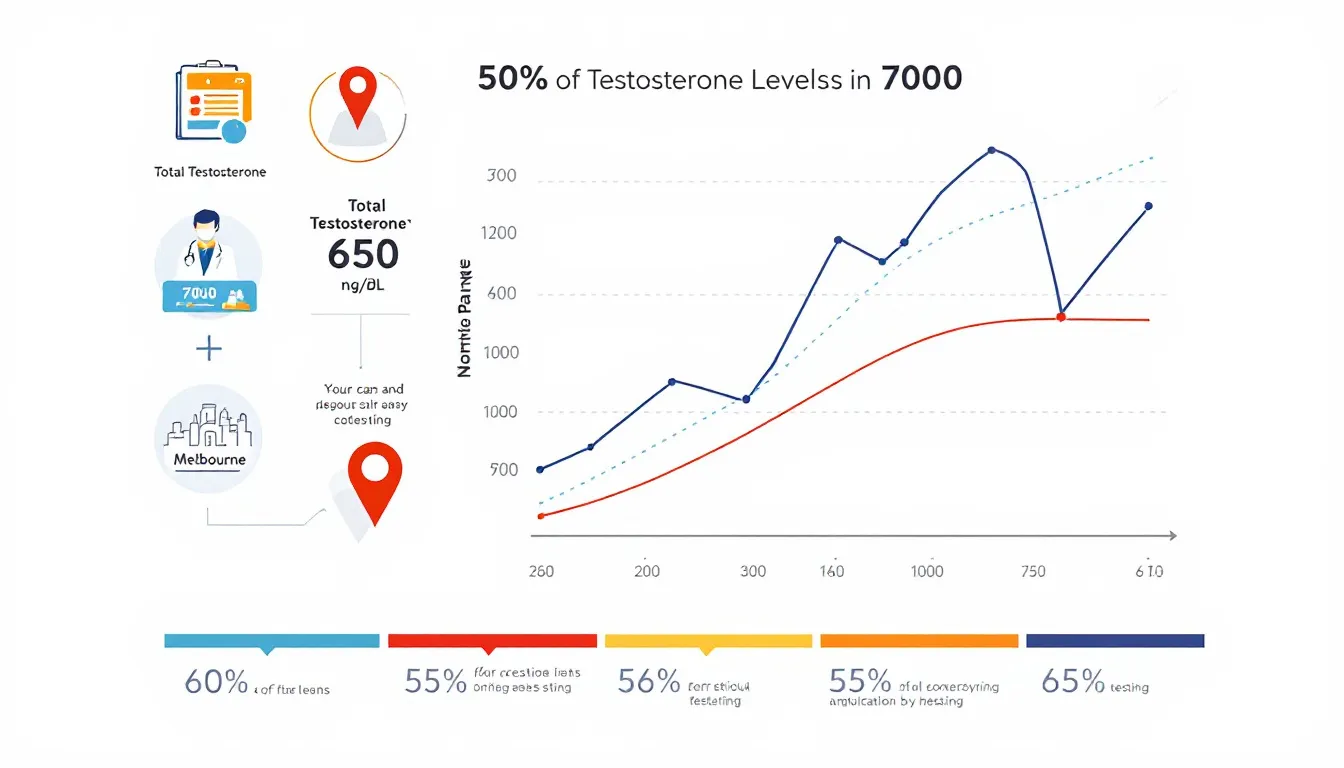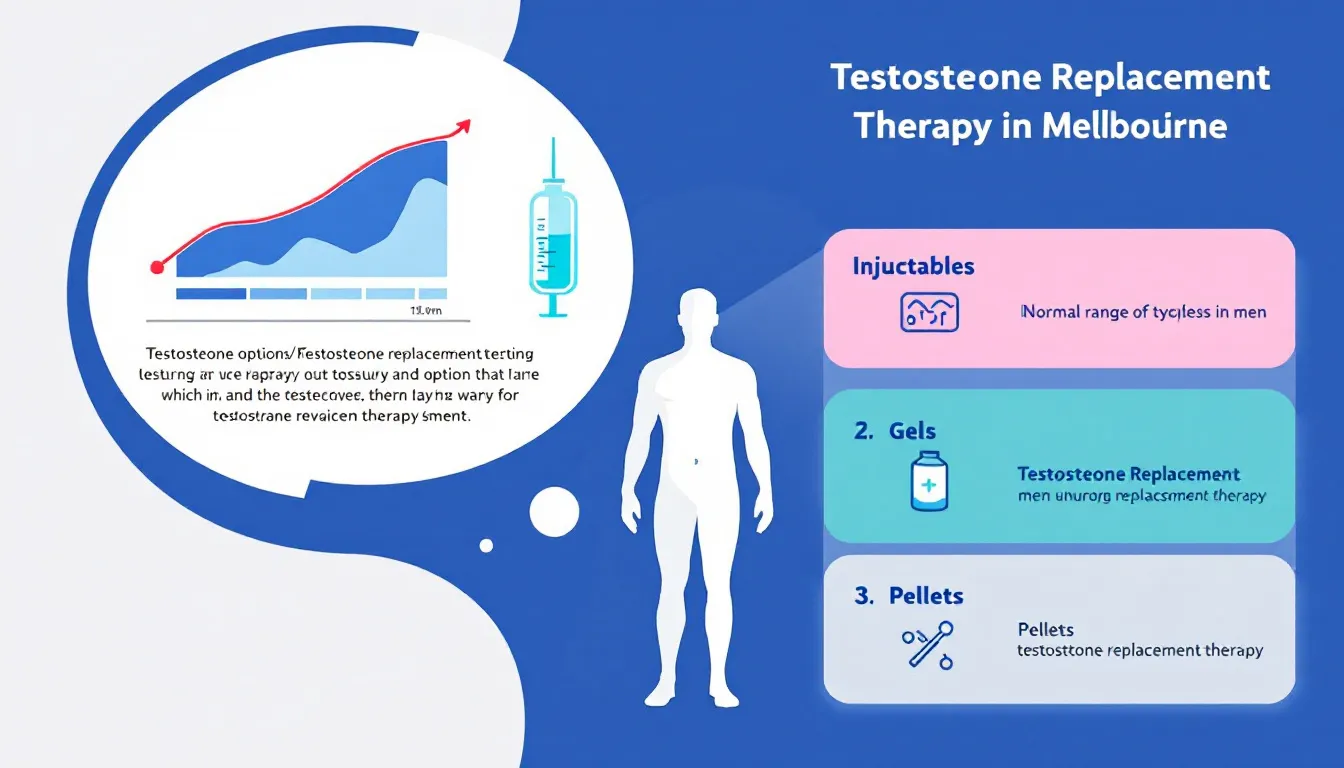Need a testosterone test Melbourne? Learn why you might need one, where to get tested, and what to expect. This guide covers the process, benefits, and preparation steps.
Key Takeaways
- A testosterone blood test is essential for diagnosing low testosterone levels, which can impact muscle mass, bone density, and sexual function in both men and women.
- Proper preparation for a testosterone test, including fasting and timing, is crucial for obtaining accurate results and ensuring effective diagnosis and treatment.
- Testosterone replacement therapy offers various delivery methods, each with unique benefits and risks, highlighting the need for personalized treatment plans and ongoing monitoring.
Understanding Testosterone Tests

Testosterone is the main male sex hormone, but it’s produced by both males and females, playing a vital role in various bodily functions. It is responsible for the growth of bones and muscles, stimulating red blood cell production, and crucially, it affects reproductive and sexual functions. In males, testosterone production primarily occurs in the testes, where they also produce sperm, while in females, it is produced in the ovaries and adrenal glands.
A testosterone blood test measures the amount of this important sex hormone in your body, helping to diagnose conditions like androgen deficiency, which is the inability to produce enough testosterone for normal body function. This deficiency can affect muscle mass, bone density, sperm production, and overall sexual function. As men age, their testosterone levels naturally decline, which can lead to symptoms that might be mistaken for other conditions.
The testosterone blood test is a crucial tool in understanding and managing these symptoms. It provides insight into whether your body is producing enough testosterone to maintain normal body functions and sexual health. For example, testosterone influences male characteristics such as facial and body hair growth, voice depth, and libido.
Knowing your testosterone levels can help you and your doctor make informed decisions about potential treatments, including testosterone replacement therapy.
Why Take a Testosterone Test?

There are several compelling reasons to undergo a testosterone blood test. Symptoms prompting such tests often include reduced libido, erectile dysfunction, and fatigue – signs that might indicate low testosterone levels. Low testosterone can also lead to sleep disturbances, mood changes, depression, and overall reduced quality of life. Chronic illnesses, hormonal disorders, or simply aging can cause low testosterone levels.
Certain medical conditions, such as diabetes and obesity, have been linked with low testosterone, making it even more crucial to monitor your levels if you suffer from these conditions. Additionally, both men and women experiencing fertility issues or other hormonal imbalances might benefit from testing their testosterone levels. For men, low testosterone and hypogonadism can sometimes be an under-diagnosed issue, emphasizing the importance of regular monitoring.
Moreover, understanding your testosterone levels can help in diagnosing related health issues. For instance, conditions like diabetes and mumps can affect testosterone levels, and knowing your baseline can guide treatment options. By identifying and addressing low testosterone early, you can take proactive steps toward maintaining your health and well-being.
Preparing for Your Testosterone Blood Test
Proper preparation for a testosterone blood test is essential for accurate results. Here are the recommended steps:
- Fast for 10-12 hours before the test, allowing only plain water during this period.
- This fasting helps ensure that the blood test accurately reflects your body’s testosterone levels without interference from food or drink.
- If you are taking medications, consult your doctor; otherwise, take them with sips of water before the test.
- Avoid smoking or chewing gum during the fasting period.
Timing is another critical factor. Testosterone levels are typically highest in the morning, so scheduling your test between 8:00 AM and 10:00 AM can provide the most accurate assessment. Adhering to these guidelines helps ensure your testosterone blood test results are precise, paving the way for an effective diagnosis and treatment.
What to Expect During the Test
When it comes time to take the testosterone blood test, knowing what to expect can help ease any anxiety. The test typically involves:
- Being performed in the morning, between 8:00 AM and 10:00 AM, to capture peak testosterone levels.
- A healthcare professional drawing blood from a vein in your arm using a small needle.
- The blood draw process usually taking under five minutes.
- Possibly feeling a mild sting when the needle is inserted or removed, though the discomfort is brief.
Often, multiple blood samples are collected on different days to account for natural fluctuations in testosterone levels, ensuring accurate and reliable results. Familiarity with this process can make you feel more prepared and at ease during your testosterone blood test.
Interpreting Your Testosterone Levels

Interpreting your testosterone levels involves understanding what the numbers mean and how they relate to your health. Testosterone tests help diagnose conditions related to both low and high testosterone levels. For men, a normal testosterone level typically ranges from 12 nmol/L or higher; levels below this threshold may suggest the need for further investigation. In women, testosterone testing can diagnose conditions like polycystic ovary syndrome.
Due to the diurnal variation of testosterone levels, which peak in the morning, timing is crucial. Multiple tests are often necessary to achieve an accurate diagnosis. Free testosterone levels, measuring the hormone not bound to proteins in the blood, can offer additional information when total testosterone levels are borderline.
Symptoms and health conditions can also influence testosterone levels, making the interpretation of results more complex. Guidelines suggest multiple assessments to confirm low levels before starting treatment. This thorough approach ensures treatment decisions are based on accurate and reliable data.
Types of Testosterone Replacement Therapy

Melbourne offers various types of testosterone replacement therapy (TRT) for those diagnosed with low testosterone. These therapies can include:
- Injections
- Implants
- Capsules
- Gels
- Patches Each method has its own benefits and considerations, allowing for personalized treatment plans.
Testosterone injections, a common form of TRT, can be administered weekly or bi-weekly, depending on the patient’s needs. Generally, these injections are given every 2 to 3 weeks. Gels provide a convenient option, maintaining relatively constant testosterone levels over 24 hours when applied to the skin.
Different testosterone delivery methods include:
- Patches: deliver consistent hormone levels but may cause skin irritation in some users.
- Nasal gels: applied multiple times daily and offer quicker absorption.
- Oral testosterone: effective but carries risks of liver complications and typically requires multiple daily doses.
Testosterone implants offer a long-term solution, releasing hormones over several months, but are not removable once implanted.
Risks and Side Effects of Testosterone Supplementation
While it offers significant benefits, testosterone supplementation comes with potential risks and side effects. One risk is increased blood viscosity, which can raise the likelihood of blood clots. Men on testosterone treatment should also be monitored for possible worsening of obstructive sleep apnea symptoms.
Testosterone supplementation may also exacerbate benign prostatic hyperplasia, leading to an increased prostate size. High testosterone levels can potentially trigger the development of gynecomastia, or breast tissue growth, in some men. Being aware of these risks is crucial for making informed decisions about testosterone therapy.
Monitoring and Follow-Up
Ongoing monitoring and follow-up are vital for successful testosterone therapy. Regular assessment of testosterone and PSA levels ensures the therapy’s safety and effectiveness. Routine blood tests are necessary to monitor hormone levels and any potential side effects.
Clinics with experienced endocrinologists and urologists are better equipped to manage testosterone therapy and its potential side effects. Strict safety protocols for monitoring patients in the clinic are also crucial.
Low rates of follow-up testing indicate that many patients may not receive adequate care after starting therapy, which can lead to a decrease in the quality of care and outcomes. The right clinic can significantly impact the quality of care and outcomes.
Choosing a Clinic in Melbourne

Choosing the right clinic for testosterone testing and therapy in Melbourne, Australia, is a critical decision. Patient feedback and reviews offer valuable insights into the quality of care and treatment success at various clinics. A reputable clinic prioritizes patient privacy, ensuring results are not shared without consent.
For example, iMedical ensures privacy for testosterone testing results by not involving Medicare numbers or aligning results with medical episodes. This level of confidentiality is crucial for many patients.
Ultimately, a reputable clinic is essential for accurate results and appropriate treatment.
Summary
Understanding testosterone and its impact on your health is vital for managing symptoms of low testosterone and related conditions. From preparing for and undergoing a testosterone blood test to interpreting the results and exploring treatment options, this guide has provided a comprehensive overview of the process.
By being informed about the types of testosterone replacement therapy and the potential risks and side effects, you can make better decisions about your health. Choosing the right clinic in Melbourne ensures that you receive the best possible care and outcomes. Take control of your health today by understanding your testosterone levels and exploring the options available to you.
Frequently Asked Questions
Why should I take a testosterone blood test?
Taking a testosterone blood test is essential if you are experiencing symptoms such as reduced libido, fatigue, or mood changes, as it can diagnose low testosterone levels and inform appropriate treatment options.
How should I prepare for a testosterone blood test?
To ensure accurate results for your testosterone blood test, it is advised to fast for 10-12 hours prior, avoid smoking or chewing gum, and schedule the test in the morning.
What are the different types of testosterone replacement therapy available?
There are several types of testosterone replacement therapy available, including injections, gels, patches, nasal gels, oral capsules, and implants, each offering distinct advantages and considerations. It is crucial to consult with a healthcare provider to determine the most suitable option for your needs.
What are the risks and side effects of testosterone supplementation?
Testosterone supplementation carries risks such as increased blood viscosity, exacerbation of sleep apnea, prostate enlargement, and gynecomastia. Regular monitoring during therapy is essential to manage these potential side effects.
How do I choose a clinic for testosterone testing in Melbourne?
To choose a clinic for testosterone testing in Melbourne, prioritize those with positive patient reviews, experienced specialists, and strong privacy policies. Reputable options, such as iMedical, are recommended for their confidentiality and quality of care.
